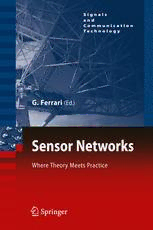Table Of ContentSpringerSerieson
SIGNALSANDCOMMUNICATIONTECHNOLOGY
SIGNALSANDCOMMUNICATIONTECHNOLOGY
SensorNetworks WirelessCommunications:2007CNIT
G.Ferrari(Ed.) ThyrrenianSymposium
ISBN978-3-642-01340-9 S.Pupolin
ISBN978-0-387-73824-6
GridEnabledRemoteInstrumentation
F.Davoli,N.Meyer,R.Pugliese,S.Zappatore AdaptiveNonlinearSystemIdentification:
ISBN978-0-387-09662-9 TheVolterraandWienerModelApproaches
T.Ogunfunmi
UsabilityofSpeechDialogSystems ISBN978-0-387-26328-1
Th.Hempel
WirelessNetworkSecurity
ISBN978-3-540-78342-8
Y.Xiao,X.Shen,andD.Z.Du(Eds.)
HandoverinDVB-H ISBN978-0-387-28040-0
X.Yang SatelliteCommunicationsandNavigation
ISBN978-3-540-78629-0 Systems
E.DelReandM.Ruggieri
MultimodalUserInterfaces
ISBN0-387-47522-2
D.Tzovaras(Ed.)
ISBN978-3-540-78344-2 WirelessAdHocandSensorNetworks
ACross-LayerDesignPerspective
WirelessSensorNetworksandApplications R.Jurdak
Y.Li,M.T.Thai,W.Wu(Eds.) ISBN0-387-39022-7
ISBN978-0-387-49591-0
CryptographicAlgorithmsonReconfigurable
PassiveEyeMonitoring Hardware
R.I.Hammoud(Ed.) F.Rodriguez-Henriquez,N.A.Saqib,
ISBN978-3-540-75411-4 A.D´ıazPe´rez,andC.K.Koc
ISBN0-387-33956-6
DigitalSignalProcessing
S.Engelberg MultimediaDatabaseRetrieval
ISBN978-1-84800-118-3 AHuman-CenteredApproach
P.MuneesawangandL.Guan
DigitalVideoandAudioBroadcasting ISBN0-387-25627-X
Technology
BroadbandFixedWirelessAccess
W.Fischer
ASystemPerspective
ISBN978-3-540-76357-4
M.EngelsandF.Petre
SatelliteCommunicationsandNavigation ISBN0-387-33956-6
Systems DistributedCooperativeLaboratories
E.DelRe,M.Ruggieri(Eds.) Networking,Instrumentation,andMeasurements
ISBN978-0-387-47522-6 F.Davoli,S.PalazzoandS.Zappatore(Eds.)
ISBN0-387-29811-8
Three-DimensionalTelevision
H.M.Ozaktas,L.Onural(Eds.) TheVariationalBayesMethod
ISBN978-3-540-72531-2 inSignalProcessing
V.Sˇm´ıdlandA.Quinn
FoundationsandApplicationsofSensor ISBN3-540-28819-8
Management
A.O.HeroIII,D.Castan˜o´n,D.Cochran, TopicsinAcousticEchoandNoiseControl
andK.Kastella(Eds.) SelectedMethodsfortheCancellationof
ISBN978-0-387-27892-6 AcousticalEchoes,theReductionof
BackgroundNoise,andSpeechProcessing
HumanFactorsandVoiceInteractiveSystems, E.Ha¨nslerandG.Schmidt(Eds.)
SecondEdition ISBN3-540-33212-x
D.Gardner-BonneauandH.Blanchard
ISBN978-0-387-25482-1 (continuedafterindex)
Gianluigi Ferrari
Editor
Sensor Networks
Where Theory Meets Practice
123
Editor
Dr.GianluigiFerrari
DepartmentofInformationEngineering
UniversityofParma
Parma,Italy
gianluigi.ferrari@unipr.it
ISSN1860-4862
ISBN978-3-642-01340-9 e-ISBN978-3-642-01341-6
DOI10.1007/978-3-642-01341-6
SpringerHeidelbergDordrechtLondonNewYork
LibraryofCongressControlNumber:2009939071
(cid:2)c Springer-VerlagBerlinHeidelberg2010
Thisworkissubjecttocopyright.Allrightsarereserved,whetherthewholeorpartofthematerialis
concerned,specificallytherightsoftranslation,reprinting,reuseofillustrations,recitation,broadcasting,
reproductiononmicrofilmorinanyotherway,andstorageindatabanks.Duplicationofthispublication
orpartsthereofispermittedonlyundertheprovisionsoftheGermanCopyrightLawofSeptember9,
1965,initscurrentversion,andpermissionforusemustalwaysbeobtainedfromSpringer.Violations
areliabletoprosecutionundertheGermanCopyrightLaw.
Theuseofgeneraldescriptivenames,registerednames,trademarks,etc.inthispublicationdoesnot
imply,evenintheabsenceofaspecificstatement,thatsuchnamesareexemptfromtherelevantprotective
lawsandregulationsandthereforefreeforgeneraluse.
Coverdesign:WMXDesignGmbH,Heidelberg
Printedonacid-freepaper
SpringerispartofSpringerScience+BusinessMedia(www.springer.com)
ToSofiaElena
mybeautifulsunshine
Preface
The idea of this book comes from the observation that sensor networks represent
atopicofinterestfromboththeoreticalandpracticalperspectives.Thetitleunder-
lines that sensor networks offer the unique opportunity of clearly linking theory
with practice. In fact, owing to their typical low-cost, academic researchers have
the opportunity of implementing sensor network testbeds to check the validity of
theirtheories,algorithms,protocols,etc.,inreality.Likewise,apractitionerhasthe
opportunity of understanding what are the principles behind the sensor networks
under use and, thus, how to properly tune some accessible network parameters to
improvetheperformance.
On the basis of the observations above, the book has been structured in three
parts:PartIisdenotedas“Theory,”sincethetopicsofitsfivechaptersareapparently
“detached” from real scenarios; Part II is denoted as “Theory and Practice,” since
the topics of its three chapters, altough theoretical, have a clear connection with
specificpracticalscenarios;PartIIIisdenotedas“Practice,”sincethetopicsofits
fivechaptersareclearlyrelatedtopracticalapplications.
In Part I, the first chapter, by H. V. Poor, examines ways in which interactions
among nodes in wireless networks can lead to greater efficiencies in the use of
wireless resources. The second chapter, by S. Sundhar Ram, V. V. Veeravalli, and
A.Nedic,developsandanalyzesdistributedandrecursivealgorithmsfornonlinear
regression-based parameter estimation in sensor networks. The third chapter, by
A.Prasath,A.Venuturumilli,A.Ranganathan,andA.A.Minai,describesaseries
of distributed methods for self-organized configuration of heterogeneous sensor
networks, and evaluates their performance using optimal configurations obtained
through an evolutionary algorithm. The fourth chapter, by A. Scaglione, Y.-W. P.
Hong,andB.S.Mergen,discussescooperativesourceandchannelcodingstrategies
and their performance in very dense sensor networks. The fifth and final chapter
of this part, by C. Fragouli, K. Argyraki, and L. Keller, provides an overview of
existingandemergingsensornetworkprotocolsthatenablereliablecommunication
inthepresenceofnodeandchannelfailuresunderenergyconstraints.
InPartII,thefirstchapter,byS.Palazzo,F.Cuomo,andL.Galluccio,introduces
ataxonomyofthemainapproachesfordataaggregationrecentlyproposedinwire-
lesssensornetworksandpresentsacomparisonbetweendifferentdataaggregation
perspectives. The second chapter, by J. Lu, Y. Pan, S. Yamamoto, and T. Suda,
vii
viii Preface
studiesdatadisseminationresilienttolargescalesensorfailuresbyreplicatingdata
toasetofsensorsformingageographicaltrajectory.Thethirdandfinalchapterof
thispart,byD.Akselrod,T.Lang,M.McDonald,andT.Kirubarajan,focusesona
problemofdecision-basedcontrolofanetworkofsensorscarryingoutsurveillance
overaregionthatincludesanumberofmovingtargets,withparticularapplication
tomultisensormultitargettracking.
In Part III, the first chapter, by J. Beutel, K. Roemer, M. Ringwald, and
M. Woehrle, surveys prominent examples of deployment techniques for sensor
networks, identifies and classifies causes for errors and pitfalls, and presents a
number of wireless sensor network specific techniques and tools for an increased
understanding of the causes of such failures. The second chapter, by J.-M. Dricot,
G.Bontempi,andP.DeDoncker,beginswithasurveyofstate-of-the-arttechniques
forlocalizationandthenproceedstomoreelaborateandrecentapproaches,basedon
machinelearning,automaticdataclassification,andsensorfusiontechniques.Inthe
thirdchapter,J.-H.Cui,R.Ammar,Z.Shi,Z.Zhou,S.Ibrahim,andH.Yan,investi-
gateshowtosmartlyutilizesurfaceradiostoenhancecapability-limitedunderwater
acoustic sensor networks. In the fourth chapter, by M. C. Vuran and A. R. Silva,
theoretical and practical insights on the problem of communication through soil
for wireless underground sensor networks is provided. The fifth and final chapter
of this part, by D. McIlwraith and G.-Z. Yang, discusses recent advances in body
sensor networks which permit pervasive sensing of detailed physiological signals
fromimplantable,wearable,andambientsensors.
Finally,Iwouldliketothankthosewhohavemadetherealizationofthisbook
possible. First of all, I am indebted to Dr. Cristoph Bauman, my Springer Engi-
neering Editor, for supporting the idea of this book from the very first discussion
at the beginning of 2008. Needless to say, all researchers that have contributed
to this book are kindly acknowledged: without them, this would not have been
possible–Ihopethatthefactthattheyareallfromacademiawillnotdisproofthe
veryideaofthebook.Last,butnotleast,mysinceregratitudegoestoafewmembers
ofourlittleWirelessAd-hocandSensorNetworks(WASN)LabattheUniversityof
Parma,namelyMarcoMartalo`,PaoloMedagliani,andStefanoBusanelli,fortheir
helpintheeditingprocessandforsharingtheinterestinsensornetworking.
Parma,Italy GianluigiFerrari
November16,2009
Contents
PartI Theory
CompetitionandCollaborationinWirelessSensorNetworks ........... 3
H.VincentPoor
DistributedandRecursiveParameterEstimation ...................... 17
SrinivasanSundharRam,VenugopalV.Veeravalli,andAngelinaNedic´
Self-OrganizationofSensorNetworkswithHeterogeneous
Connectivity ....................................................... 39
Arun Prasath, Abhinay Venuturumilli, Aravind Ranganathan,
andAliA.Minai
CooperativeStrategiesinDenseSensorNetworks ..................... 61
AnnaScaglione,Y.-W.PeterHong,andBirsenSirkeciMergen
MultipathDiversityandRobustnessforSensorNetworks .............. 75
ChristinaFragouli,KaterinaArgyraki,andLorenzoKeller
PartII TheoryandPractice
Data Aggregation in Wireless Sensor Networks: A Multifaceted
Perspective ........................................................103
SergioPalazzo,FrancescaCuomo,andLauraGalluccio
RobustDataDisseminationforWirelessSensorNetworksinHostile
Environments .....................................................145
JunLu,YiPan,SatoshiYamamoto,andTatsuyaSuda
ix
x Contents
MarkovDecisionProcess-BasedResourceandInformationManagement
forSensorNetworks ...............................................167
David Akselrod, Thomas Lang, Michael McDonald,
andThiagalingamKirubarajan
PartIII Practice
DeploymentTechniquesforSensorNetworks .........................219
JanBeutel,KayRo¨mer,MatthiasRingwald,andMatthiasWoehrle
Static and Dynamic Localization Techniques for Wireless Sensor
Networks .........................................................249
Jean-MichelDricot,GianlucaBontempi,andPhilippeDeDoncker
Enhancing Underwater Acoustic Sensor Networks Using Surface
Radios:Issues,ChallengesandSolutions .............................283
ZhongZhou,HaiYan,SalehIbrahim,Jun-HongCui,ZhijieShi,
andRedaAmmar
Communication Through Soil in Wireless Underground Sensor
Networks–Theory andPractice ....................................309
M.CanVuranandAgneloR.Silva
BodySensorNetworksforSport,WellbeingandHealth ................349
DouglasMcIlwraithandGuang-ZhongYang
Index .............................................................383

